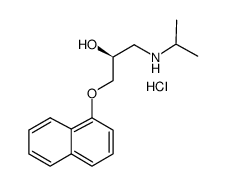(S)-(-)-PROPRANOLOL HYDROCHLORIDE

(S)-(-)-PROPRANOLOL HYDROCHLORIDE structure
|
Common Name | (S)-(-)-PROPRANOLOL HYDROCHLORIDE | ||
|---|---|---|---|---|
| CAS Number | 4199-10-4 | Molecular Weight | 295.80400 | |
| Density | N/A | Boiling Point | 434.9ºC at 760mmHg | |
| Molecular Formula | C16H22ClNO2 | Melting Point | 193-195ºC(lit.) | |
| MSDS | Chinese USA | Flash Point | 216.8ºC | |
| Symbol |

GHS07 |
Signal Word | Warning | |
|
Chemical genetics reveals a complex functional ground state of neural stem cells.
Nat. Chem. Biol. 3(5) , 268-273, (2007) The identification of self-renewing and multipotent neural stem cells (NSCs) in the mammalian brain holds promise for the treatment of neurological diseases and has yielded new insight into brain cancer. However, the complete repertoire of signaling pathways ... |
|
|
Genetic mapping of targets mediating differential chemical phenotypes in Plasmodium falciparum.
Nat. Chem. Biol. 5 , 765-71, (2009) Studies of gene function and molecular mechanisms in Plasmodium falciparum are hampered by difficulties in characterizing and measuring phenotypic differences between individual parasites. We screened seven parasite lines for differences in responses to 1,279... |
|
|
The Alpha-1D Is the Predominant Alpha-1-Adrenergic Receptor Subtype in Human Epicardial Coronary Arteries
J. Am. Coll. Cardiol. 54 , 1137-45, (2009) Objectives The goal was to identify alpha-1-adrenergic receptor (AR) subtypes in human coronary arteries. |
|
|
A behavioural and biochemical study in mice and rats of putative selective agonists and antagonists for 5-HT1 and 5-HT2 receptors.
Br. J. Pharmacol. 84 , 743-753, (1985) Radioligand binding techniques have demonstrated the existence of 5-hydroxytryptamine (5-HT) binding subtypes: 5-HT2, 5-HT1A and 5-HT1B. These techniques have also indicated that certain drugs appear to show sub-type specificity: 8-hydroxy-2-(di-n-propylamino... |
|
|
Stereoselective vascular effects of the (R)- and (S)-enantiomers of propranolol and atenolol.
J. Cardiovasc. Pharmacol. 25 , 268-272, (1995) All beta-adrenergic antagonists have an asymmetric carbon atom, and most commercially available beta-blockers consist of (R)- and (S)-enantiomers in a fixed 1:1-ratio. The drugs are believed to be contraindicated when peripheral vascular disease exists, presu... |
|
|
Reversal of propranolol blockade of adrenergic receptors and related toxicity with drugs that increase cyclic AMP.
Proc. Soc. Exp. Biol. Med. 221 , 382-385, (1999) An overdose of propranolol, a widely used nonselective beta-adrenergic receptor blocking agent, can result in hypotension and bradycardia leading to irreversible shock and death. In addition, the blockade of adrenergic receptors can lead to alterations in neu... |
|
|
Stereoselective blockade of central [3H]5-hydroxytryptamine binding to multiple sites (5-HT1A, 5-HT1B and 5-HT1C) by mianserin and propranolol.
J. Pharm. Pharmacol. 39 , 664-666, (1987) The interaction of the enantiomers of mianserin and propranolol with the binding of [3H]5-hydroxytryptamine ([3H]5-HT) to the 5-HT1A, 5-HT1B and 5-HT1C sites, and with the binding of [3H]ketanserin to the 5-HT2 site, has been evaluated in rat brain membranes.... |
|
|
The effects of propranolol on heterogeneity of rat cerebral small vein oxygen saturation.
Anesth. Analg. 89 , 690-695, (1999) beta-Adrenergic receptors are involved in altering cerebral metabolism and blood flow. This study was performed to determine whether propranolol would alter the microregional O2 balance in the brain. Rats were anesthetized with 1.4% isoflurane. Isotonic sodiu... |
|
|
Effects of cyclosporin on the pharmacokinetics of propranolol after intravenous and oral administration to control rats and to rats with uranyl nitrate-induced acute renal failure.
J. Pharm. Pharmacol. 51 , 1149-1154, (1999) The effects of cyclosporin on the pharmacokinetics of propranolol have been investigated after intravenous and oral administration of the drugs to control rats and to rats with uranyl nitrate-induced acute renal failure. The effects of intravenous cyclosporin... |